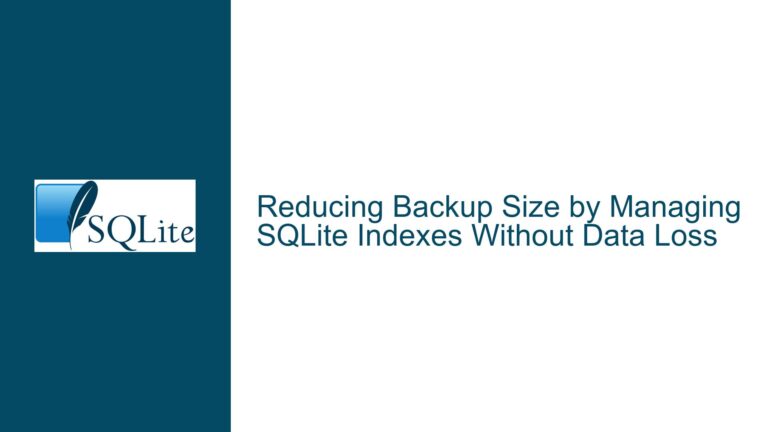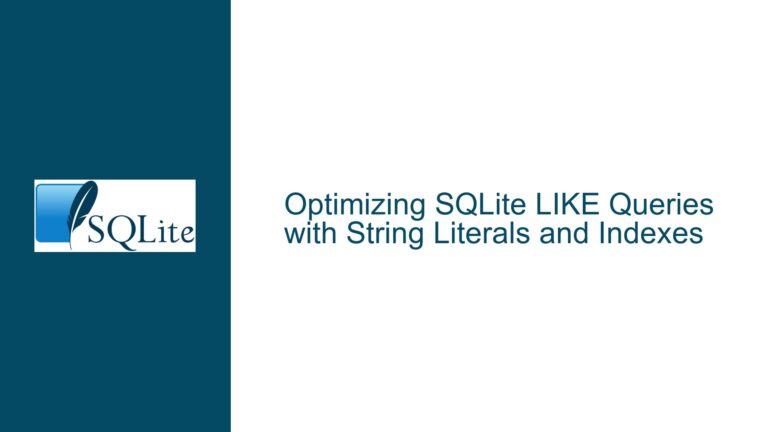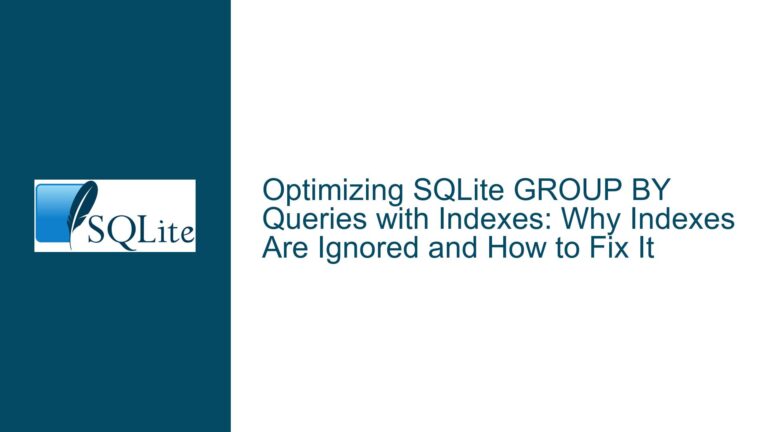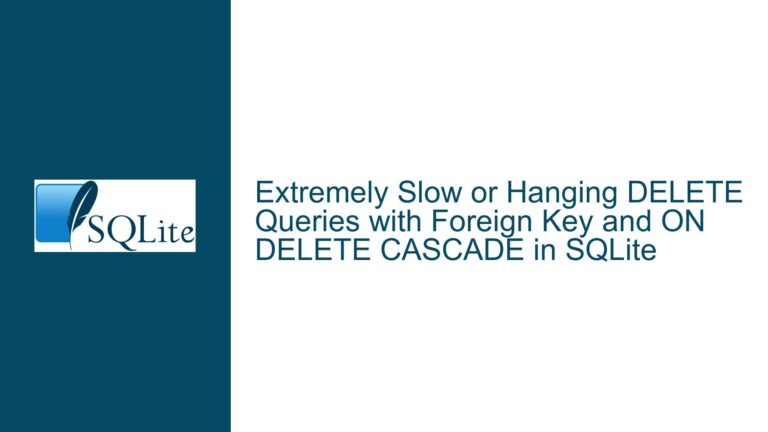SQLite WASM Database Loading Behavior: Memory Usage and OPFS VFS Interactions
Understanding SQLite WASM Database Storage and Memory Management
Issue Overview
SQLite’s WebAssembly (WASM) implementation introduces unique challenges and opportunities for database storage and memory management in web environments. A common concern among developers is whether SQLite WASM loads the entire database into memory upon initialization, particularly when handling large datasets or binary large objects (BLOBs). This concern stems from the limitations of browser-based storage mechanisms and the potential for excessive memory consumption, which can degrade application performance or cause crashes.
SQLite WASM operates within the browser’s JavaScript runtime, relying on browser APIs for persistent storage. The default storage mechanism for SQLite WASM is kvvfs, which stores database pages in localStorage or sessionStorage. These key-value stores are inherently memory-constrained and lack direct disk access guarantees. However, modern browsers support the Origin Private File System (OPFS), a sandboxed file system accessible via the FileSystemAccess API. When configured with an OPFS-backed Virtual File System (VFS), SQLite WASM can interact with a more robust storage layer that mimics traditional file I/O behavior.
The critical distinction lies in how different VFS implementations manage data:
- In-memory VFS: Stores the entire database in memory, suitable for temporary or small datasets.
- kvvfs VFS: Relies on
localStorage/sessionStorage, which may implicitly load the entire database into memory due to JavaScript’s synchronous storage APIs. - OPFS VFS: Allows SQLite to read/write database pages on-demand from disk, reducing memory footprint by fetching only required data during queries.
Developers using SQLite WASM must understand these layers to avoid inadvertently loading large databases into memory. For example, a database containing 1 GB of BLOBs stored via OPFS VFS would not load all data into memory at once. Instead, SQLite’s pager component would fetch specific pages as needed during query execution. However, misconfiguration (e.g., using kvvfs for large datasets) can lead to the entire database being loaded into memory, overwhelming the browser’s capacity.
Diagnosing Excessive Memory Usage in SQLite WASM Applications
Possible Causes
Excessive memory consumption in SQLite WASM applications can arise from multiple factors, often related to VFS configuration, query patterns, or browser-specific storage behavior.
Incorrect VFS Selection:
- Using the default kvvfs VFS for large databases forces the entire dataset into memory because
localStorageandsessionStorageare synchronous and lack granular read/write control. - Failing to configure the OPFS VFS when targeting persistent, large-scale storage leaves the application reliant on memory-bound storage mechanisms.
- Using the default kvvfs VFS for large databases forces the entire dataset into memory because
Unoptimized Query Patterns:
- Queries that perform full-table scans or load entire BLOBs into JavaScript heap memory (e.g.,
SELECT * FROM blobs) bypass SQLite’s page-level caching, forcing all relevant pages into memory. - Transactions that modify large datasets without incremental commits can accumulate dirty pages in memory, increasing pressure on the JavaScript runtime.
- Queries that perform full-table scans or load entire BLOBs into JavaScript heap memory (e.g.,
Browser Storage Limitations:
localStoragetypically enforces a 5–10 MB limit per origin, making it unsuitable for large databases. Exceeding this limit truncates data or throws errors.- OPFS quotas are managed by the browser and may vary, but they generally allow larger storage (e.g., hundreds of MBs). However, developers must request persistent storage permissions to avoid automatic data eviction.
VFS-to-Storage Layer Mismatch:
- Custom VFS implementations that do not properly interface with OPFS’s asynchronous API may fall back to buffering entire files in memory.
- Misuse of Emscripten’s virtual filesystem (e.g., MEMFS) for SQLite operations forces all database files to reside in memory.
JavaScript-to-WASM Memory Transfers:
- Copying BLOB data from WASM memory to JavaScript variables (e.g., via
sqlite3_column_blob()) duplicates the data in the JavaScript heap, doubling memory usage.
- Copying BLOB data from WASM memory to JavaScript variables (e.g., via
Resolving Memory Overhead in SQLite WASM: Configuration, Optimization, and Best Practices
Troubleshooting Steps, Solutions & Fixes
Step 1: Validate VFS Configuration
Action: Ensure the SQLite WASM build is configured to use the OPFS VFS for persistent storage.
- Example initialization code:
const sqlite3 = await sqlite3InitModule({ print: console.log, printErr: console.error, }); const opfsVfs = await sqlite3.OPFSVFS(); const db = new sqlite3.oo1.DB('/mydb.sqlite3', 'c', opfsVfs); - Verification: Check the VFS name using
db.filenameVfs(), which should returnopfs.
- Example initialization code:
Pitfall Avoidance:
- Avoid using
kvvfsfor databases larger than 1 MB. - Do not rely on the default VFS, which may be memory-based.
- Avoid using
Step 2: Optimize Query Patterns for Page-Level Loading
Action: Structure queries to minimize the number of pages loaded into memory.
- Use indexed queries to reduce full-table scans:
CREATE INDEX idx_username ON users(username); SELECT * FROM users WHERE username = 'alice'; - For BLOB retrieval, use
sqlite3_blob_open()to stream data incrementally instead of loading entire BLOBs.
- Use indexed queries to reduce full-table scans:
Memory Profiling:
- Use Chrome DevTools’ Memory tab to monitor JavaScript heap and WASM memory usage during query execution.
- Identify queries causing spikes in memory and refactor them to use pagination or streaming.
Step 3: Configure OPFS for Persistent Storage
- Action: Request persistent storage permission to prevent browser eviction:
if (navigator.storage && navigator.storage.persist) { const isPersisted = await navigator.storage.persist(); console.log('Storage persisted:', isPersisted); } - Quota Management:
- Estimate storage usage with
navigator.storage.estimate()to ensure OPFS quotas are not exceeded.
- Estimate storage usage with
Step 4: Minimize JavaScript/WASM Memory Transfers
- Action: Avoid copying BLOB data between WASM and JavaScript unless necessary.
- Use
sqlite3_blob_read()to read BLOB chunks directly from WASM memory. - Store frequently accessed metadata in separate tables to reduce BLOB access frequency.
- Use
Step 5: Implement Incremental Commit Strategies
- Action: For write-heavy operations, split transactions into smaller batches:
db.exec('BEGIN;'); for (let i = 0; i < 1000; i++) { db.exec(`INSERT INTO data VALUES (${i}, '...')`); if (i % 100 === 0) { db.exec('COMMIT; BEGIN;'); } } db.exec('COMMIT;'); - Benefit: Reduces the number of dirty pages held in memory during transactions.
Step 6: Monitor and Adjust Browser-Specific Behavior
- Action: Test across browsers to identify varying OPFS or storage behaviors.
- Firefox and Safari may handle OPFS synchronization differently than Chromium-based browsers.
- Use feature detection to fall back to in-memory storage when OPFS is unsupported.
Step 7: Leverage SQLite Configuration Options
- Action: Adjust SQLite’s page cache size to balance memory and performance:
PRAGMA cache_size = -2000; -- 2000 KB cache - Considerations:
- Smaller cache sizes reduce memory usage but may increase I/O operations.
- Larger caches improve performance for frequently accessed data.
Step 8: Use Emscripten’s Memory Initialization Options
- Action: Configure Emscripten’s memory allocation to match expected database usage:
const sqlite3 = await sqlite3InitModule({ initialMemory: 64 * 1024 * 1024, // 64 MB maximumMemory: 256 * 1024 * 1024, // 256 MB }); - Rationale: Prevents runtime memory allocation failures during large queries.
Step 9: Audit Third-Party Libraries and Plugins
- Action: Ensure any SQLite extensions (e.g., Full-Text Search, JSON1) do not inadvertently load excessive data into memory.
- Test extensions in isolation to measure memory impact.
Step 10: Implement Offloading Strategies for Large BLOBs
- Action: Store BLOBs outside the database when possible.
- Use OPFS directly for BLOB storage and store file handles in SQLite:
// Write BLOB to OPFS const file = await opfsRoot.getFileHandle('blob1', { create: true }); const writable = await file.createWritable(); await writable.write(new Blob([binaryData])); await writable.close(); // Store reference in SQLite db.exec(`INSERT INTO blobs (id, opfs_path) VALUES (1, 'blob1')`); - Retrieve BLOBs via
fetch()orFileReaderAPIs when needed.
- Use OPFS directly for BLOB storage and store file handles in SQLite:
By systematically addressing VFS configuration, query optimization, and browser-specific storage behavior, developers can ensure SQLite WASM applications handle large databases efficiently without overwhelming memory resources.






